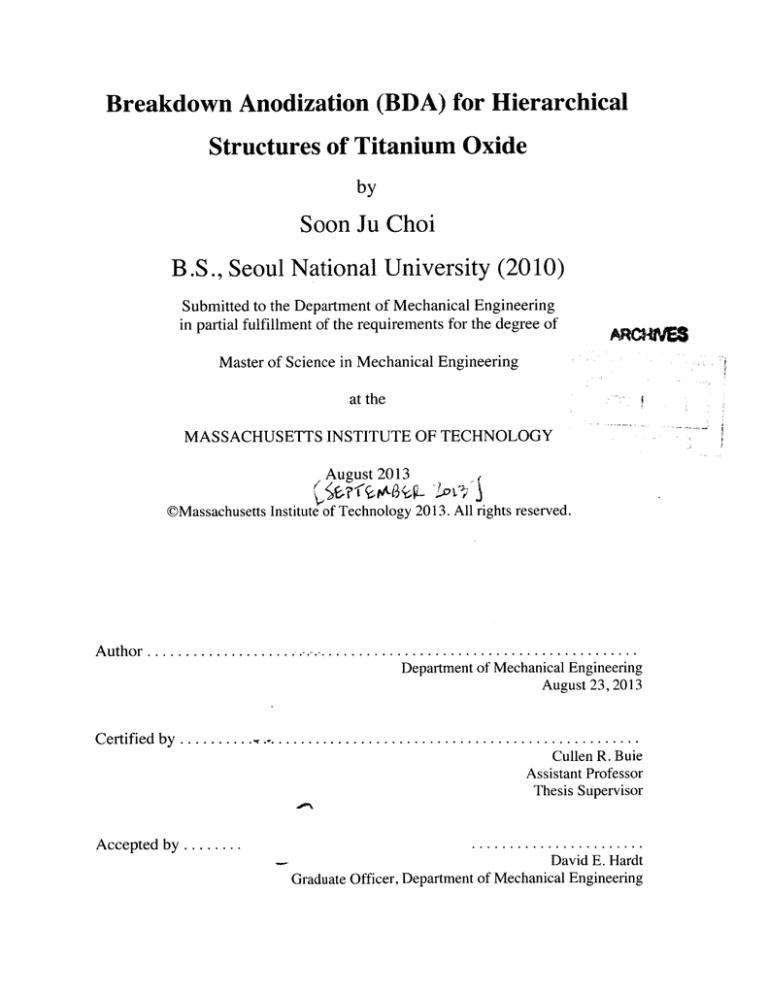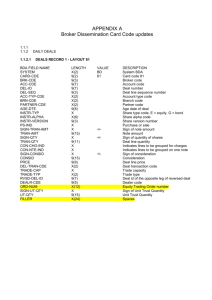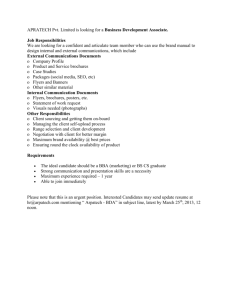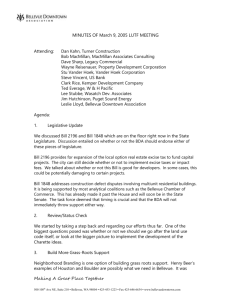
Breakdown Anodization (BDA) for Hierarchical
Structures of Titanium Oxide
by
Soon Ju Choi
B .S., Seoul National University (2010)
Submitted to the Department of Mechanical Engineering
in partial fulfillment of the requirements for the degree of
ARCHMVE
Master of Science in Mechanical Engineering
at the
MASSACHUSETTS INSTITUTE OF TECHNOLOGY
August 2013
©Massachusetts Institute of Technology 2013. All rights reserved.
Author...........................................................
Department of Mechanical Engineering
August 23, 2013
Certified by .........
.........
............................
Cullen R. Buie
Assistant Professor
Thesis Supervisor
Accepted by ........
David E. Hardt
Engineering
of
Mechanical
Graduate Officer, Department
2
Breakdown Anodization (BDA) for Hierarchical
Structures of Titanium Oxide
by
Soon Ju Choi
Submitted to the Department of Mechanical Engineering
on Aug 16, 2013, in partial fulfillment of the
requirements for the degree of
Master of Science in Mechanical Engineering
Abstract
Breakdown Anodization (BDA) of titanium dioxide is a very promising, fast
fabrication method to construct micro-scale and nano-scale structures on titanium
surfaces. This method uses environmentally friendly electrolytes, such as nitric
acid, and can be fabricated within 30 minutes regardless of substrate size. Because
the titanium dioxide is hydrophilic, the micro structured BDA surface exhibits
super-hydrophilic properties. BDA surfaces can be applicable to water transport,
chromatography, electrospray, and fabrication of hierarchically structured
surfaces. In this study we investigate the wicking properties of BDA surfaces and
quantify their performance in terms of capillary pressure and capillary spreading
speed constant. Further, we investigate the application of BDA surfaces to
electrospray for the separation and identification of chemical agents.
Thesis Supervisor: Cullen R. Buie
Title: Assistant Professor
3
4
Acknowledgements
I would like to thank my advisor, Professor Cullen Buie, for his guidance and
support throughout my master's program. I have learned a great deal from him,
especially in developing my career path as an engineer.
I would also like to thank my colleagues, Youngsoo Joung, Zhife Ge,
Qianru Wang, William Braff, Bruno Figliuzzi, Alisha Schor, Naga Neehar
Dingari,
Andrew Jones,
and Pei Zhang, at Laboratory
for Energy
and
Microsystems Innovations. They have provided me with invaluable advice and
encouragement. I want to send my special appreciation to Youngsoo Joung who
has given me great insight into my research with his experiences and wisdom.
I also want to send thanks to Professor Sang-gook Kim and Rohit Karnik
for giving me opportunity to work in such a great environment, and Dr. Jim Bales
in Edgerton Center who provided me the high speed camera for my research. I am
also indebted to Byung Gu Cho, Kyoo-Chul Park and friends for their support and
kind words.
Lastly, I want to send my appreciation to Chong-Hwan Lee, the founder of
Kwanjeong Foundation, for supporting me and believing in my possibilities. He
has been my mentor, cheering me through the ups and downs.
And above all, my warmest regard and deepest love goes to my family in
Korea.
5
6
Contents
1 Introduction
13
1.1 M otivation of the Research .................................
13
1.2 G oal of the Research .....
14
................................
15
2 Research Background
2.1 Capillary Flow .........................................
15
2.2 A nodization Process ....................................
17
2.3
2.2.1 Breakdown Potential ...............................
19
2.2.2 Breakdown Anodization (BDA) Process ................
20
2.2.3 Temperature of BDA Process ........................
21
2.2.4 Etching Process ..................................
22
Soil M atric Potential ....................................
22
2.4 Electrospray ...........................................
28
3 Fabrication Method
3.1
25
Breakdown Anodization (BDA) .............................
28
3.2 Capillary Rise Experiment .................................
30
3.3 Electrospray ...........................................
31
7
34
3.4 Safe Etching Process .....................................
4 Experiments, and Results
36
4.1 W etting Properties .....................
.. ................
4.2 Soil Experiment ........................................
5 Applications
43
44
5.1 Electrospray ............................................
5.1.1 Chrom atography ...
36
..............................
5.1.2 Droplet Formation ................................
5.2 Hierarchical Structure by Etching Process .....................
6 Conclusions, and Future Work
44
45
49
52
55
8
List of Figures
2-1
Anodization, breakdown anodization (BDA), and etching according to
electrolyte condition .......................................
17
2-2
Graph for Water content and Matric suction ......................
24
2-3
Apparatus for traditional capillary tip electrospray .................
26
3-1
Circulation bath for control temperature, and BDA apparatus with
thermal couple to measure the electrolyte temperature ..............
29
3-2
Capillary rise experim ent ....................................
31
3-3
Experimental materials and equipment for electrospray .............
32
3-4
Electrospray connected to power supply .........................
33
3-5
Etching Process, and capillary rise experiment of etched BDA surface .
35
4-1
Capillary Rise Experiment at constant temperature 20'C ............
37
4-2
Initial height to find spreading speed constant at 30V, 60V, 90V, 120V
at constant temperature (20'C) ................................
38
4-3
Constant Voltage 90V, and maximum capillary height .............
39
4-4
Initial height to find spreading speed constant of commercial TLC
Plate, optimized condition (90V, 10 C) BDA surface .............
4-5
41
After 30 minute of capillary rise experiment for TLC, Optimized BDA
surface, and scratched BDA surface ............................
9
42
4-6
Soil experiment result after 30 minutes ..........................
43
5-1
Electrospray performance comparison with respect to tip sharpness ...
45
5-2
Chromatography performance comparison using permanent marker on
TLC plate and BDA surface ..................................
5-3
47
Chromatography performance comparison using Rodamine B, Methyle
Blue, and Fluorescein 1.5 wt% Methanol solution on TLC plate and
B DA surface ..............................................
48
5-4
Image taken before establishing the Taylor cone ..................
49
5-5
Droplet formation .........................................
50
5-6
Droplet moving at the initial locations ..........................
51
5-7
SEM image of hierarchical structure at micro scale ................
53
5-8
Nano Structures of Hierarchical Structure at High magnitude ........
54
10
List of Tables
2-1
Soil data is from Shada H. Krishnapillai .........................
4-1
Values of maximum capillary height
and spreading speed constant
(20 0 C ) .. . . .....
4-2
......
..
(Hmax),
24
capillary pressure (Pcap),
at constant electrolyte temperature
(Ccap)
.. ... .. . ....
Values of maximum capillary height
(Hmax),
.. .. .. . . .. .. . . .. ... .
capillary pressure
(Pcap),
and spreading speed constant (Ccap) at constant applied voltage .......
4-3
Values of maximum capillary height
and spreading speed constant
(Ccap)
(Hmax),
38
40
capillary pressure (Pcap),
for commercial TLC Plate ....... .41
11
12
Chapter 1
Introduction
1.1
Motivation of the Research
Titanium dioxide is a promising material, which can be applied to various
applications with various fabrication methods. Applications include photocatalysis
[1], catalysis [2], solar cells [3], and biomedical devices [4]. When the titanium is
anodized, its surface can be modified to various structures with special properties
according to electrolyte condition and applied voltage.
Breakdown anodization is an anodization method using titanium substrate
[6], which is able to rapidly fabricate microstructures using an environmentally
friendly electrolyte, nitric acid.
13
1.2
Goal of the Research
Tianium dioxide is high surface energy and BDA surface is conductive material
having various applications. First, it is important to determine how experimental
conditions including electrolyte temperature and applied voltage affect the surface
properties. This would enable the fabrication of BDA surfaces with specific,
deterministic properties by adjusting the experimental conditions.
Through this study, BDA surfaces are applied to electrospray and this work
also explores fabrication of hierarchical titanium surfaces by coupling BDA with
other etching processes.
14
Chapter 2
Research Background
2.1
Capillary Flow
BDA surfaces are hydrophilic, the wetting line rises to certain height when it
contact the water reservoir. The hydrophilic BDA surface can be modeled as
columns of capillaries and the wetting behavior can be approximated by
Washburn's equation [5].
dh
-=dt
rz2 2y cos 0
yPo
9
8 h
r
(2.1)
Where h is the vertical height of the liquid; t is the elapsed time after liquid contact;
r is the assumed pore radius; y is the liquid surface tension; p is the liquid density;
rq, 0, and g are the liquid viscosity, surface native contact angle, and gravitational
15
constant, respectively. At the initial stage, the gravity term is negligible and
equation (2.1) becomes [6],
2
ry'cos0
i=
t=
1
Ccapt
(2.2)
Where Ccapis called the spreading speed constant. From the initial elapsed time of
capillary rise experiment, the curve for liquid height according to time can be
obtained to find the spreading speed constant by curve fitting.
Capillary pressure can be calculated when the liquid reachs the maximum
rise height. At this location the gravitational force balances the capillary force,
assuming negligible liquid evaporation. Then the time term of equation (2.1) is
neglected and balances the rest terms and becomes [6],
Pcap
HmaxgP
r
Where Hmax indicates the maximum capillary height.
16
(2.3)
2.2
Anodization Process
The anodization process forms a thin oxide layers on the positive electrode [7].
Traditional titanium anodization forms thin and compact titanium dioxide layers.
One of example conditions for this thin compact layers is anodization in pH.1.0
H3PO 4 electrolyte with 100V/cm applied voltage [8].
Compact T10
Typical
Electrolytes
Mildly Acidic
Electrolyte
(pH. 3 H NO3)
2
ce
Etched T102
Nanotubes
Electrolyte
Containing
Halogen ions
_
T102 BDA + Etching Surface
Figure 2- 1: Anodization, breakdown anodization (BDA), and etching according to
electrolyte conditions.
Also instead of using titanium, other materials such as Zr [9], Ta [10], and W [11]
can be used to form oxide films. The anodic film formation on the titanium surface
is governed by following reaction [6],
17
<Anode>
Electrolysis:
2H 2 0 ->0
2
(g) + 4H' + 4e-
(2.4)
Corrosion:
Ti -
(2.5)
Ti+ + e-
Oxidation:
Ti + 2H 20 () -TiO
Ti +0
2
-
2
+ 4H + 4e-
(2.6)
(2.7)
TiO 2
Dissolution:
TiO 2-x + H20 () -> TiO 2 -H 20 (s)
(2.8)
TiO 2 + H 20+ H+ -> Ti(OH) 3
(2.9)
<Cathode>
Electrolysis:
(2.10)
4H 20 + 4e -> 2H 2 (g) + 40H
Electrodeposition:
Ti 3++ 3e- - Ti
(2.11)
18
Electrolysis (2.10) and dissolution (2.8), (2.9) are continuous processes during
anodization. Corrosion and electrodeposition terminate at the initial state because
the formed oxide layer prevents the both reactions. At steady state, therefore,
electrolysis, oxidation, and dissolution mainly occur yielding the overall reaction,
0.5 Ti + 2H 2 0 (1)
4
0.5 TiO2 + 2H 2 (g) + 0.5 02 (g)
(2.12)
2.2.1 Breakdown Potential
The breakdown of the oxide layer was theoretically well explained by the paper of
Sato in 1971 [12]. The surface pressure during the anodization process can be
explained by main two forces, an electrostriction effect and the interfacial tension
effect as follows;
P= PO +
E
E-
-
1)E 2
8zc
ye
(2.13)
L
with the vertically acting pressure P; the atmospheric pressure PO; electric field E;
dielectric constant of the film
E; e surface
tension of the oxide film; and oxide
film thickness L.
When the surface tension has a major effect on the surface, the
electrochemical property of electrolyte and electrodes must be considered to
19
predict the breakdown conditions because ion adsorption of the film surface
affects the surface tension. The break down electric field, EC on the oxide layer can
be expressed as follows [6];
E =
(2.14)
'L
where electrode potential 0; and equilibrium potential between the oxide layer and
the electrolyte of ; and thickness L. After breakdown occurs, the electrode
potential /*,
can be expressed by [12]
8
df/*
d*= _-8k~ IkBTP a
dna
899r0o - e(E + 1)Ec
(2.15)
where the activity of anion in the electrolyte is a; and absorption density of anions
is pa At higher temperature conditions, critical potential will be lowered.
2.2.2 Breakdown Anodization (BDA) Process
Breakdown occurs when the electric potential exceeding the breakdown potential
and forms the micro structures on the electrode. This phenomenon is typically
20
observed over 60 V when pH 3 nitric acid was used for the process. The process
forms micro sized structures on the surface, increasing it's roughness. Because the
static contact angle of titanium dioxide with water is below 900, BDA surfaces are
hydrophilic. This surface, therefore, is ideal for highly absorbent applications such
as extracting fluids from soil in which high absorbency is necessary.
2.2.3 Temperature of BDA process
The oxide layer thickness of the BDA process is mainly governed by the
electrolyte temperature and applied electric potential for a given electrolyte. The
dissolution rate is the hydration process of titanium dioxide layer, which governs
the oxide film thickness. Electrolyte temperature largely affects the hydration rate;
therefore, temperature of the electrolyte controls the oxide film thickness [56].
The oxide layer thickness can be measured using the surface capacitance
because the oxide layer thickness is inversely proportional to the capacitance of
the oxide layer, 1/C [13]. A relation suggested by Bockris et al. [14] is as follows,
dln(C
dt
1
_
1
AH
RT
with time, t; universal gas constant, R; and activation energy, AH.
21
(2.16)
2.3.4 Etching Process
Etching process is mostly governed by chemical dissolution of the oxide layer by
the presence of halogen ions in the electrolyte. The most common chemical
material used for this process is hydrogen fluoride. The reaction converting the
oxide layer to the soluble fluoride complex is as follows [7],
MeO 2 + 6F- -> [MeF 6]
(2.17)
Me4 + 6F- -> [MeF 6 ]2 -
(2.18)
This process transforms the oxide layer, MeO 2 , to water soluble MeF6 complexes.
The small radius vacancy made by dissolved oxide initiates the process. The
complex formation continuously dissolves MeO 2 and prevents Me(OH)xOy
precipitation by transforming the arriving Me" ions at the oxide/solution interface
to soluble MeF 6 complexes.
2.3
Soil Matric Potential
Unsaturated soil is a porous media which readily absorbs liquids. Soil science
characterizes the medium by the matric potential or matric suction with respect to
22
the soil water content. The required energy to remove water held between the soil
pores is matric potential. Matric suction is the same absolute value but the
opposite sign as the matric potential. Normalized water content or effective
saturation of the soil can be related by following expression [15],
S =
= 0
r
OS - O,.
=
11 + (ay)
l
(2.19)
where,
S, 0 are effective saturation, and normalized water content;
yf is matric potential;
O
'S, and
0
r
are volumetric water content, saturated water content, and residual
water content, respectively;
a, n, and m are parameters relate to soil properties.
23
1.OE+06 -
---- Madrid Clay Sand
1.OE+05 -
Madrid Gray Clay
Maryland Clay
1.OE+04 1.OE+03 -
1.OE+02 1.OE+01-
1.OE+00
0.1
0
0.3
0.2
0.4
0.5
0.6
0.7
0.8
0.9
1
Nomalized water content
Figure 2-2:
Graph for Water content and Matric suction based on the van
Genuchten Model from equation 2.19, data is from Shada H. Krishnapillai, [16].
Table 2-1: Soil data is from Shada H. Krishnapillai [16]. Parameters a, n, and m is
properties of soil for equation 2.19.
Soil Type
Madrid clay sand
Madrid gray clay
Maryland clay
Porosity
0.275
0.507
0.448
Uquid Umit
28%
71%
64%
a
0.028
0.0015
0.0004
n
2.55
0.75
1.65
m
0.125
0.425
0.245
As shown above, the matric suction decreases as the water content
increases. Also when the water content is the same, the small pore size soil or clay
24
has larger matric suction values than that of larger sized soil (e.g. sand). It means
that the retained water between the small pores requires more energy to extract
than larger pore size soil when it has identical water content.
2.4
Electrospray
Traditional electrospray uses stainless capillary tips (diameter about 1mm) to form
gas phase ions. Depending upon whether it is connected to the positive electrode
or negative electrode, the spray is denoted positive mode or negative mode. Most
electrospray applications use the positive mode, which makes positive ions. The
electric field at the tip is calculated by following equation (Loeb et al., 1941, [17]).
2V
E = R (/
R In (4d1 R)
(2.20)
with the electric field, Ec; the applied potential, V; distance from the tip and the
counter electrode, d; and the capillary outer diameter, R. It means that the electric
field is proportional to the applied voltage and inversely proportional to the
distance from the tip and the counter electrode, and the capillary outer diameter.
25
As the applied voltage increases, the electric field also increases and the
solution at the tip eventually becomes the Taylor cone shape when it starts
electrospray. The positive ions mostly located at the surface of Taylor cone spray
positive ion-rich droplets to the counter electrode. As soon as the positive ion rich
droplet leaves the tip to the counter electrode, the solvent of the solution (usually
methanol) evaporates until ions become gas phase due to the repulsive force
between the ions.
liquid
capillary
1MM
Figure 2-3: Apparatus for traditional capillary tip electrospray (left), and spray
formation (right). Spray occurs and a Taylor cone is formed at 4.0 kV. The
solution surface is positively charged due to the electric field.
26
Instead of using tubular capillaries, stainless steel needles [18, 25], tungsten oxide
nanowire[19], wooden toothpicks [20], or even paper [21-24] have been used as
electrospray tips. Although these tip are not conductive, electrospray occurs
because the applied solution was conductive. These tips are able to make small
diameter electrosprays compared to traditional capillaries. The advantage is that
these systems can utilize smaller sample volumes than traditional capillaries.
27
Chapter 3
Fabrication Method
3.1
Breakdown Anodization (BDA)
The cathode and anode for the BDA process were prepared from the titanium
plates (Ultra Corrosion-Resistant Titanium grade 2, 0.02" thick). Their dimensions
were 10 mm x 170 mm. To eliminate contaminants on the titanium electrodes,
each sample was cleaned with acetone, methanol, isopropanol, and DI water. The
cathode and anode were assembled maintaining a 10 mm distance by inserting
non-conducting material between the electrodes.
28
Four electrodes were immersed into acetic acid at pH 3 and a constant
voltage (range 30V-120V) was applied for 30 minutes. Using a circulation bath
(polystat, Cole-Parmer), the temperature during the process was held constant
(range 10'C - 25*C). Stirrer with 800rpm was used to circulate the electrolyte to
eliminate the by-products on electrodes. After the entire process the BDA surfaces
were cleaned with DI water.
Figure 3-1: Circulation bath for control temperature (left), and BDA apparatus
with thermal couple to measure the electrolyte temperature (right).
29
The temperature of the circulating liquid was maintained five degrees below the
target temperature to account for heat generation during BDA. The circulating
liquid maintains the electrolyte temperature by removing the heat produced due to
BDA.
A more direct way to control the electrolyte temperature is to use the
electrolyte as the circulating fluid. In this case the electrolyte temperature is set
directly by the water bath, eliminating the need for stirring or a thermocouple.
3.2
Capillary Rise Experiments
Capillary rise experiments are utilized to measure the capillary pressure and
spreading speed constant of the BDA surface. The microstructure of the BDA
surface depends on the fabrication conditions- including electrolyte temperature,
electrolyte pH, and applied voltage. As a result, the spreading speed and rise
height on the BDA surface change under different fabrication conditions.
The capillary rise experiment consists of the following steps. First, the
BDA surface is placed in the water reservoir. Then, the stage is adjusted such that
the liquid comes into contact with the BDA surface. Spreading speed constant is
calculated within the first five minutes. After 30 minutes, a photo is taken to
determine the maximum capillary rise height.
30
camera
Figure 3-2: Capillary rise experiment (left), and image of the experiment before
and after 0.5 seconds the sample is emerged water (right).
3.3
Electrospray
As discussed in section 2.4, the electrospray performance depends on the electric
field at the edge of the capillary or tip. Therefore, it is important to sharpen the
BDA tip to maximize the electric field and lower the required applied voltage. In
general, the sharp edge showed better performance compared to the planar edge.
31
Figure 3-3: Experimental materials and equipment for electrospray.
Methanol was used as solvent due to its high evaporation rates. Chemicals
were also added in solution to enhance the conductivity and for detection by mass
spectrometry. The methanol solution was 1.5 wt% methanol with Methyl Blue,
Fluorescein, and Rhodamine B fluorescent dyes. Due to its distinct color and
different mobility on the BDA surface, it is straightforward to identify the
chemicals with the naked eye during the experiment.
32
Figure 3-4: Electrospray was connected to a power supply and ready to spray.
As mentioned earlier, the distance between the counter electrode and the BDA
surface was 10 mm. Also to focus electric field to the upper-side of the BDA
surface which contained the liquid analyte, the bottom side of the BDA surface
was electrically insulated from the electrode. After the solution placed onto the
BDA surface, a 4.5 kV of electric potential was applied using a power supply.
Immediately after the solution reached the BDA tip, it emitted small droplets to
counter electrode.
33
3.4
Safe Etching Process
This section explores fabrication of hierarchical titanium surfaces by coupling
BDA with safe etching process using HCl solution instead of using conventional
HF solution. The BDA surface prepared were used as the positive electrode for
additional etching process fabricating nano-structures on BDA micro-structures.
Electrodes were assembled using a copper anode [26] as a counter electrode. This
assembly was immersed into the 3M HC while applying a constant potential of 10
V for 10 minutes. A stirrer was not used during this process and the surfaces were
cleaned using DI water.
34
Figure 3-5: Etching Process (left), and capillary rise experiment of etched BDA
surface. First sample from the right is etched BDA surface (right).
35
Chapter 4
Experiments, and Results
4.1
Wetting Properties
The capillary rise experiment measures two values; 1) Pap: capillary pressure, and
2) Cap: spreading speed constant. The result of the capillary rise experiment can
be used to compare the wicking ability of the BDA surfaces to commercial
materials such as thin layer chromatography (TLC) plates (Sigma-Aldrich,
aluminum support, silica gel matrix, layer thickness 200 y m, particle size 25 'U
m). The experiments reveal that the BDA surfaces have higher capillary pressure
and spreading speed constant than the commercial TLC plates.
36
The spreading speed constant and capillary pressure can be obtained using
equations (2.2), and (2.3). From the equation (2.3), Pcap = Hmaxgp, capillary
pressure is proportional to the maximum rise height.
In section 2.2.3, we verify that the applied voltage can affect the
microstructure at the surface. To find the optimized voltage, we applied voltages
of 30 V, 60 V, 90 V, and 120 V.
Figure 4-1: Constant temperature 20'C, left after 15 minutes, right after 30
minutes. Almost reached maximum capillary height after 15 minutes.
37
1000
*30V
900
*60V
800
700
M
.----
920V
*120V
600
500
400
300
300
--- 9
--
200
100
0
0
5
15
10
20
25
Time (s)
Figure 4-2: Initial height to find spreading speed constant at 30V, 60V, 90V, 120V
at constant temperature (20*C). The slope of the lines indicates the spreading
speed constant.
Table 4-1: Values of maximum capillary height (Hmax), capillary pressure (Pap),
and spreading speed constant (Cap) at constant electrolyte temperature (20*C) with
respect to applied voltage.
H.
30V BDA
60V BDA
90V BDA
120V BDA
(mm)
35
80
80
55
PW (kPa)
0.35
0.81
0.81
0.56
38
Cm (mm 2/s)
12
30
33
17
The best performance of capillary pressure and capillary spreading constant was
found at 90 V with values of 0.81 kPa, and 33 mm2 /s for capillary pressure and
capillary spreading constant, respectively.
Figure 4-3: Constant Voltage 90V, and maximum capillary height. 30 minutes
after immersed into the water.
39
Table 4-2: Values of maximum capillary height (Hmax), capillary pressure
and spreading speed constant
(Ccap)
(Pcap),
at constant applied voltage (90V) with respect
to electrolyte temperature.
0 C,
10
90V BDA
150C, 90V BDA
200 C, 90V BDA
Hmx (mm)
100
90
75
Pp (kPa)
1.1
9.9
0.83
C
M (mm 2 /s)
55
50
41
We also find that the temperature affects the microstructure of the BDA
surface. Surfaces were fabricated at temperatures of 10 0 C, 15'C, and 20'C. The
best performance was obtained at 90 V, and 20'C electrolyte temperature. At this
condition, capillary pressure was 1.lkPa, and the capillary spreading constant was
55 mm 2 /s.
40
3000
*TLC
2500
90V
2 90V Scratch
2500
100,~--A
A
1000
500
10
20
30
40
50
60
70
Time (sec)
Figure 4-4: Initial height to find spreading speed constant of commercial TLC
Plate, optimized condition (90V, 10 'C)
BDA surface, and vertically scratched
BDA surface. The slope of the lines indicates the spreading speed constant.
Table 4-3: Values of maximum capillary height (H.,), capillary pressure (Pcap),
and spreading speed constant (Ccap) for commercial TLC Plate, optimized
condition (90V, 10 'C) BDA surface, and vertically scratched BDA surface.
TLC
BDA90V
BDA 90V Scratch
P.
HMU (MM)
40
80
85
41
(kPa)
0.40
0.81
0.86
C,
(rm2/s)
3
25
41
Moreover, the BDA surface is more resistive than the commercial TLC
plate because the BDA surface is directly fabricated on the titanium metal
substrate instead of being deposited on the substrate. Also from the capillary rise
experiment with DI water, its capillary pressure was 0.8 kPa, compared to the
capillary pressure of the commercial TLC of 0.4 kPa. The surface also showed
faster spreading speed with a value of 25 mM2 /s, eight times faster than the TLC
plate. Also, it was found that vertical scratches on the surface enhanced the
capillary pressure and capillary speed. The capillary pressure increased by 125%
for the 90 V BDA surface.
Figure 4-5: After 30 minute of capillary rise experiment for TLC, Optimized BDA
surface, and scratched BDA surface.
42
4.2
Soil Experiment
Soil experimentation is required for the application of remote sensing as
introduced in part 1. Titanium BDA surfaces are made from robust metal, making
it ideal for use in soil wicking. In this experiment, the maximum volumetric liquid
limit of soil was 31.9%.
When its water content increases the matric suction of the soil decreases as
investigated at section 2.3 and finally can be ignored when it is saturated. Even
when the water content was below (5 ml/35 ml) the BDA surface wicked the water
8 mm.
43
Figure 4-6: Soil capillary rise experiment result after 30 minutes. From left to right
5ml, 10ml, 11.5ml water was added into 35ml soil.
Chapter 5
Applications
5.1
Electrospray
Traditional electrospray uses stainless steel syringe tips, composite materials and
even paper. According to each tips characteristics, the electrospray resulted in
various droplet sizes. Using the BDA surface, we could expect that the
electrospray would separate the solutes due to its chromatographic effect. The
BDA surface also results in smaller droplets at the tip because BDA has smaller
44
pore size than the conventional electrospray. For electrospray using the BDA
surface, we first determined the chromatographic effect, which can be used to
separate the chemicals in solution according to their mobility. Electrospray
properties were analyzed afterwards.
Figure 5-1: Electrospray performance comparison with respect to tip sharpness
(angle of edge, left: 900, right: 300). Two pictures are taken after 10 seconds after
power was applied.
5.1.1 Chromatography
We used a permanent marker (Sharpie) and an ethanol solution of fluorescein,
rhodamine b, and methyl blue. The BDA surface was compared with the
commercial TLC plate for their capability of chromatography. For the black
45
permanent marker, it separated yellow and green color by 70 mm from black ink
while the commercial TLC plate only seperated the purple color 33mm. TLC plate
failed to separate the yellow and green colors from the purple solute and stayed as
a mixture at the maximum rise height 33 of mm.
Also when separating the rodamine b, methyl blue, and fluorescein 1.5 wt%
methanol solution, TLC plates only separated red (Rodamine B), yellow
(Fluorescein), and blue color (Methyl Blue) by 35mm, 37mm, and 40mm,
respectively. The BDA surface moved the blue, yellow, and red color 5mm, 45mm,
and 55mm, respectively. This verifies that the BDA surface showed better
performance in terms of solute separation.
46
Figure 5-2: Chromatography performance comparison using black permanent ink
on the TLC plate and the BDA surface.
47
Figure 5-3: Chromatography
performance comparison using Rodamine B,
Methyle Blue, and Fluorescein 1.5 wt% Methanol solution on the TLC plate and
the BDA surface.
48
5.1.2 Droplet Formation
A high speed camera (Ektapro model 1012, Redlake MASD Inc) was used to
observe the formation of droplets at the tip of BDA surface.
<Taylor Cone Formation>
Figure 5-4: Left image was taken before establishing the Taylor cone. The right
image was captured after 4 milliseconds.
Taylor cone formed at the tip of the BDA surface. The electric field pulls the
solution to the left, overcoming the surface tension of the solution.
49
<Droplet Formation>
Figure 5-5: Droplet formation. After 4.3 ms of reference time and right is after 4.8
ms from reference time.
Droplets formed as the force from the electric field overcomes the surface tension
of the liquid. When the electric field reaches the critical value, the liquid is
stretched by the opposing electrical force and surface tension. Eventually the
droplet totally separates from the liquid, yielding a spherical droplet.
50
<Droplet Average Speed>
Figure 5-6: Droplet moving at the initial locations. Left is after 5.2 ms from the
reference time, and 6.4 ms from the reference time.
In figure 5-6, droplet moved 1.7mm for 1.2 ms and the average droplet speed was
1.4m/s.
51
5.2
Hierarchical Structure by Etching Process
The BDA surface consists of irregular micro structures. These irregular micro
structures contribute to its hydrophilicity. Adding nanoscale structures to the
microstructures resulting from BDA would increase the surface area. The use of
acid halide electrolyte such as HCl, and HF instead of using mild acid results in
surface etching of titanium substrate.
As a result, homogeneous nano halls, which diameters are approximately
20nm, are successfully produced on the micro-porous structures of BDA surfaces.
The hierarchical structures composed of micro and nano structures produced by
BDA and etching provides much higher surface area than nanostructures of planar
titanium surface. Moreover, using HCl as the electrolyte, instead of using the
traditional electrolyte, HF, it could be fabricated in a safe environment.
52
Figure 5-7: SEM image of hierarchical structure at micro scale. HCl was used as
an electrolyte for etching process. Nano-structures are observed on microstructures.
53
Figure 5-8: Nano Structures of Hierarchical Structure at High magnitude and can
verify the nanostructures (approximate diameter: 20nm) on the micro-structures.
54
Chapter 6
Conclusions, and Future Work
We confirmed that BDA surfaces have better performance in terms of capillary
pressure and spreading speed constant than that of commercial TLC plates. Also
we found that we can adjust the BDA surface properties according to the
fabrication conditions.
For the future work, mass spectrometry analysis is necessary to verify if the
electrospray made by BDA surface successfully separates solutes from solution.
Experiments were performed to maximize the droplet size and to verify that
electrospray with the naked eye. Future work focuses more on minimize the
droplet size for better analysis of solute by mass spectrometry.
Finally, more investigation in the hierarchical BDA surface is needed to
obtain the enhanced surface areas to apply specific applications.
55
56
Bibliography
[1] Akira Fujishima, Kenichi Honda. "Electrochemical Photolysis of Water at a
Semiconductor Electrode." Nature, no. 238 (1972): 37-38.
[2] M. Valden, X. Lai, D. W. Goodman. "Onset of Catalytic Activity of Gold
Clusters on Titania with the Appearance of Nonmetallic Properties."
Science, no. 281 (1998): 1647-1650.
[3] Brian O'Regan, Michael Gratzel. "A low-cost, high-efficiency solar cell
based on dye-sensitized colloidal TiO2 films." Nature, no. 353 (1991): 737739.
[4] Young-Taeg Sul, Carina B. Johansson, Sarunas Petronis, Anatol Krozer,
Yongsoo Jeong, Ann Wennerberg, Tomas Albrektsson. "Characteristics of
the surface oxides on turned and electrochemically oxidized pure titanium
implants up to dielectric breakdown: the oxide thickness, micropore
configurations,
surface
roughness,
crystal
structure
and
chemical
composition ." Biomaterials,no. 23 (2002): 491-501.
[5] Washburn, Edward W. "The Dynamics of Capillar Flow." The Physics
Review 17, no. 3 (1921): 273-283.
[6] Young Soo Joung and Cullen R. Buie "A Hybrid Method Employing
Breakdown
Anodization
and
57
Electrophoretic
Deposition
for
Superhydrophilic Surfaces
."
The Journalof Physical Chemistry B, no. 117
(2013).
[7] J.M. Macak, H. Tsuchiya, A. Ghicov, K. Yasuda, R. Hahn, S. Bauer, and P.
Schmuki. "TiO2 nanotubes: Self-organized electrochemical formation,
properties and applications ." Current Opinion in Solid State and Materials
Science, no. 11 (2007): 3-18.
[8] Neide K. Kuromoto, Renata A. Simio, and Gloria A. Soares. "Titanium
oxide films produced on commercially pure titanium by anodic oxidation
with different voltages ." Maerials Characterization,no. 58 (2007).
[9] Hiroaki Tsuchiya and Patrik Schmuki. "Thick self-organized porous
zirconium oxide formed in H2SO4/NH4F electrolytes ." Electrochemistry
Communications,no. 6 (2004): 1131-1134.
[10] I. Sieber, B. Kannan, and P. Schmuki. "Self-Assembled Porous Tantalum
Oxide Prepared in H 2 SO 4 / HF Electrolytes." Electrochemical and
Solid-State Letters, no. 8 (2005): J10-J12.
[11] Hiroaki Tsuchiya, Jan M. Macak, Irina Sieber, Luciano Taveira, Andrei
Ghicov, Kamila Sirotna, and Patrik Schmuki. "Self-organized porous
W03 formed in NaF electrolytes." Electrochemistry Communications, no.
7 (2005): 295-298.
[12] Sato, N. "A Theory for Breakdown of Anodic Oxide Films on Metals."
ElectrocimicaActa 16 (1971): 1683-1692.
58
[13] M.W. Breiter, "Galvanostatic studies of passivity and breakdown of
passivity of titanium in hydrochloric acid solutions." ElectrochimicaActa
15, no. 7 (1970): 1195-1200.
[14] J. O'M. Bockris and E. C. Potter "The Mechanism of Hydrogen Evolution
at Nickel Cathodes in Aqueous Solutions ." The Journal of Chemical
Physics 20, no. 614 (1954): 614-628.
[15] M. Th. van. Genuchten, "A Closed-form Equation for Predicting the
Hydraulic Conductivity of Unsaturated Soils." Soil Science Society of
America Journal44, no. 5 (1979): 892-898.
[16] Shada H. Krishnapillai, and Nadarajah Ravichandran. "New Soil-Water
Characteristic
Curve
and
Its
Performance
in
the
Finite-Element
Simulation of Unsaturated Soils ." INTERNATIONAL JOURNAL OF
GEOMECHANICS 12, no. 3 (2012): 209-219.
[17] L. B. LQEB, A. F. KIP, and G. G. Hudson. "Pnlses in Negative Point-toPlane Corona." Physics Review 60 (1941): 714-722.
[18] Kenzo Hiraoka, Kentaro Nishidate, Kunihiko Mori, Daiki Asakawa and
Shigeo Suzuki. "Development of probe electrospray using a solid needle."
Rapid Communications in Mass Spectrometry 21 (2007): 3139-3144.
[19] Jingyueh Jeng, Che-Hsin Lin, and Jentaie Shiea. "Electrospray from
Nanostructured Tungsten Oxide Surfaces with Ultralow Sample Volume
."Analytical Chemistry 77, no. 24 (2005): 8170-8173.
59
[20] Bin Hu, Pui-Kin So, Zhong-Ping Yao. "Analytical Properties of Solidsubstrate Electrospray Ionization Mass Spectrometry ." Americal Society
for Mass Spectrometry 24 (2012): 57-65.
[21] He Wang, Jiangjiang Liu, R. Graham Cooks, and Zheng Ouyang. "Paper
Spray for Direct Analysis of Complex Mixtures Using Mass Spectrometry
."Angewandte Chemie InternationalEdition 49 (2010): 877-880.
[22] Nicholas E. Manicke, Qian Yang, He Wang, Sheran Oradu, Zheng
Ouyang, R. Graham Cooks. "Assessment of paper spray ionization for
quantitation of pharmaceuticals in blood spots ." InternationalJournalof
Mass Spectrometry 300: 123-129.
[23] Jiangjiang Liu, He Wang, Nicholas E. Manicke, Jin-Ming Lin, R. Graham
Cooks,
and
Zheng
Ouyang.
"Development,
Characterization,
and
Application of Paper Spray Ionization ." American Chemical Society 82
(2010): 2463-2471.
[24] Ryan D. Espy, Ariel R. Muliadi, Zheng Ouyang, R. Graham Cooks.
"Spray mechanism in paper spray ionization ." InternationalJournal of
Mass Spectrometry 325-327 (2012): 167-171.
[25] Lee Chuin Chen, Kentaro Nishidate, Yuta Saito,Kunihiko Mori, Daiki
Asakawa, Sen Takeda, Takeo Kubota, Hirokazu Hori, and Kenzo
Hiraoka. "Characteristics of Probe Electrospray Generated from a Solid
Needle." Journalof Physcal Chemistry B 112 (2008): 11164-11170
60
[26] Xiaobo Chen, Maria Schriver, Timothy Suen, Samuel S. Mao.
"Fabrication of 10nm diameter TiO2 nanotube arrays by titanium
anodization." Thin Solid Films 515 (2007): 8511-8514.
61







